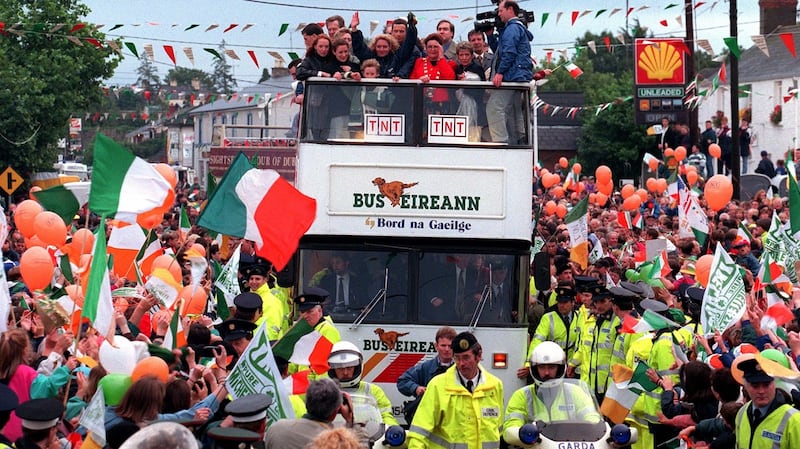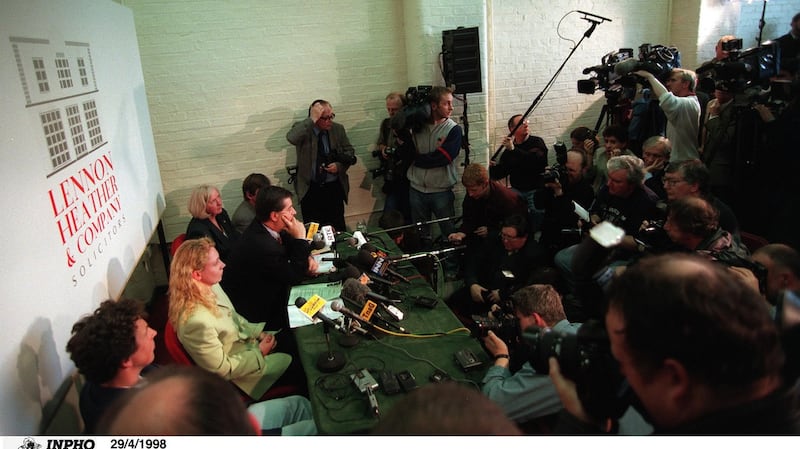Atlanta in 1996 and we brought the Friday to a close watching the opening ceremony in a bar. Francis Barrett, the first Traveller to carry the Irish flag. Muhammad Ali trembling up the ramps, still a fearless look in his eyes, humbling us all.
The Olympic Torch. Bill Clinton. Celine Dion. The UN. The Temple of Zeus. The Parade of Nations. Gladys Knight and Georgia on My Mind.
We chose beer in Buckhead rather than the stadium. The feelgood factor was sold hard by the Atlanta Olympic organising committee. Lapping it up, there was no reason why that mood would change.


Three Irish gold medals later and we should have all been back in the party district in the home of Coca-Cola sweltering in swamp heat, dissecting a week of weeks in the pool and watching the closing ceremony from a safe distance.
We should have been harvesting goodwill and teaching the world to sing. But we weren’t. All it took to put a bitter twist on 16 days of the Olympic Games were the first four.
Head-to-heads
Michelle Smith, her straw coloured hair still wet from showering and her face flushed from a second gold medal swim in the 400 metres freestyle, appeared guarded as the room fell to a hush.
She was composed, expecting what was coming and like an academic taking questions from a class of undergraduates, her tone was forthright and calm.
We stood at the back among the television cameras wondering what way it could break. It was Monday, early in her Olympic schedule and already the press conferences had become as hot as Georgia asphalt.
They were fractious head-to-heads that pinballed from the obsequious framing of her as a pool heroine to adroitly hostile inferences of poison in the water.
Smith had already broken American hearts, destroying the field in the 400m individual medley for her first gold medal the previous Saturday, beating the USA’s Allison Wagner into second place by over two seconds.
Lines had been drawn. America saw her success as a stunning hijack of their swimming competition and we, new to it all, as an unfolding morality tale tumbling through a week of bad spirits.
Missing from the conference was American Janet Beth Evans, a world champion and world record holder, who won four gold medals at the 1988 and the 1992 Olympics. The American was ninth in the heats and hadn't even made the final.
Smith, looking the least astonished person in the room, now had the gold medal of an American darling. To that backdrop a deflated Evans had whispered locker-room gossip to a friendly microphone hours earlier, when she had dropped the nickel.
“If you are asking if the accusations are out there, I would say that yes, they are,” said Evans. “I’ve heard a lot of things from a lot of people. You ask me like I know, I don’t know. But it’s a topic of conversation on the pool deck.”
Fluent in Irish, English and Flemish the articulate Smith was also visually enchanting with her gold medals and golden hair. Her Irishness charmed soft-focus USA. But there was also a competing narrative, that her Olympics were becoming a fairy story.
Do you understand why the fairy story question is posed asked an Irish journalist, the inference being that such stories are not real.
"Yes," replied Smith. "I think the difference between here and in Europe is that in Europe people have seen me and the changes I have made in my training. Maybe that's why it was a bit of a surprise."
The charges were simple. Smith was not ranked among the top 25 female swimmers in the world at any distance in any stroke in 1993. By then she had met her partner Erik de Bruin, a Dutch discus thrower serving a four-year doping ban and with no background in swimming. It was then she began to rip through the record books. Now in 1996 a double Olympic champion and poised for a third and possibly even fourth win.
She hadn’t swum a competitive 400m freestyle in 12 years before the previous month, yet here she was. That too was hurled towards the top table.
“I think that’s another fairy story,” she shot back. A good cop Australian then dived to her defence. Was she surprised at how ungracious the US team and media had been?
“Not surprised,” said Smith. “Disappointed. I’ve worked very, very hard for this, put my heart and soul into this, trained six days a week, six hours a day, all I do is eat, sleep and train.”
Puncturing the mood, Irish speaker and broadcaster Seán Bán Breathnach stood up. At the front of the room speaking as Gaeilge he softballed her and asked if she was intending to run for secretary of the UN.
Smith smiled and answered in Irish. But his gambit to change the tone was brief. Again the mood pivoted back to a kind of estrangement. Words had already been weaponised. Her “remarkable” gains. Her “extraordinary” performances. Her “incredible” times. Her age. She was 26.
"I can't remember exactly how many times I've been tested," she said. "But I know in May, June they came to my house and the same day, later on, I had an unannounced test by the Olympic Council of Ireland. I was going back to Holland and I said to the Fina guy, 'oh I'm very popular with Fina drug testing, I'll expect to see you again'. The same guy called to me in Holland two weeks later."
But Evans’s earlier poolside assassination would not leave the room. Nor would the deep fault lines the American swimmer had created. Evans had kicked the hornet’s nest. Have you ever been tempted to take drugs? Janet said she would never be tempted. Would you?
“No, absolutely not,” said Smith. “It would be a really stupid thing for me to do, something like that. Once you are in the top 20 in the world rankings you are liable to be tested at any time by Fina or your own federation.
“I’ve been sitting at home at 9am on a Sunday morning and the drug testers have come to my door. You are in your pyjamas and these people want a urine sample. It’s part of the job. You are not going to be that stupid.”
Irish mist
Al and Kay Guy did not call at 9am. It was dark when they arrived at Kellsgrange House in Kilkenny in early January 1998 at 7.40am. There was little sign of life in the De Bruin residence and the gates into the drive were padlocked. So the two testers sat in the car until the house stirred.
The Kays turned up everywhere. That was their job. They turned up in apartments and training venues and hotels with their specimen flasks. That day it was the house of the triple Olympic champion and they had come for their 70 millilitres of urine.
When the front door opened Michelle emerged and walked down the drive to unlock the gates. She re-entered her house and disappeared from view. Al Guy walked up to the kitchen door, which was ajar, and observed that she was neither in the kitchen nor in the corridor that led from it.
He waited outside, while his wife unloaded the testing equipment from their car. They both waited until her return. Al and Kay Guy estimated that she was out of their sight for between four and six minutes. De Bruin put the time at closer to one to two minutes.
She supplied, according to the Court of Arbitration for Sport (Cas) report, 30 millilitres of urine on her first attempt. She then sat for approximately 25 minutes before departing to the lavatory a second time with Kay. It is not unusual to be unable to supply a full sample in one instance.
When they returned the volume of urine sample was adequate but both testers noticed a distinct smell of alcohol. Neither said anything while they were in the house but later mentioned it to each other in the car and in testimony to the Cas.
Kay said it smelled something like Irish Mist with Al thinking it was more like Southern Comfort.
On January 14th, 1998, the laboratory in Barcelona acknowledged receipt of the two containers A 074396 and B 074396. It took 16 days before the laboratory sent its analysis report on the A sample to Fina, world governing body of swimming.
It stated: “Unequivocal signs of adulteration have been found in sample coded A 074396. The content of alcohol of the sample (concentration higher than 100 mg/ml) is in no way compatible with human consumption and the sample shows a very strong whisky odour. Its very low specific gravity (0.983 g/ml) is also compatible with a physical manipulation.
“Additional laboratory results obtained with the sample (especially, steroid profile and isotope ratio mass spectrometry measurements) suggest the administration of some metabolic precursor of testosterone.”
The analysis of the B sample was performed on May 21st, 1998 at the laboratory. Counsel for Michelle Smith de Bruin attended in part due to frenzied media coverage of conspiracy theories.
The Versapak containers could be secretly opened by boiling and closed without the lab knowing. Debunked. The sample had been deliberately contaminated. Debunked. Fina were out to “get”’ the Irish swimmer. Debunked. Al and Kay Guy were in on it. Debunked.
That same day the report was sent to Fina. It confirmed what the A sample had provided.
Because a banned substance was found in the urine, Cas concluded there was something to conceal. Not only was the manipulation not wholly successful, it said, but “there was an obvious motive for it”.
A hearing before the Fina doping panel was held in July 1998, where the accusation of tampering with a sample was made. The following month the panel found that Michelle Smith de Bruin, under Fina rules, had committed a doping offence.
She was immediately suspended from all participation in any Fina governed swimming events for a period of four years. Her swimming career was over.
Royal reward
From the icy chill of the air conditioned conference room, four times we melted out into the stifling Georgian summer, overheated and antsy. Insects the size of swallows were dive bombing on Peachtree Avenue. Gold. Gold. Gold. Bronze. Four Olympic medals. All of it was foreign to us. The weight of her medal tonnage that week placed Ireland fourth on the swimming table behind USA, Russia and Hungary and above China and Australia.
What had begun in Atlanta as no more than an ill wind had ended in career catastrophe two years later in Kilkenny by way of a Barcelona laboratory and a Lausanne court.
Far from a royal reward for Ireland’s dazzling queen of the pool.













